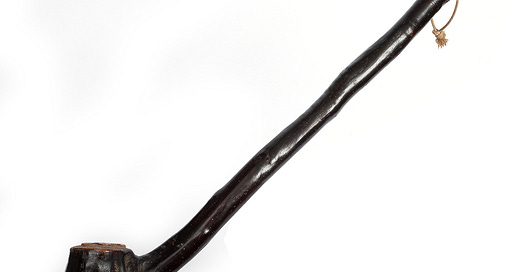What Is A Shillelagh?
A shillelagh is a traditional Irish walking stick and cudgel, renowned for its rich cultural heritage and unique craftsmanship. It is a symbol deeply embedded in Irish folklore and history, often associated with the valor and resilience of the Irish people.
The Origins of the Shillelagh
The name "shillelagh" (pronounced shih-LAY-lee) is derived from the Shillelagh Forest in County Wicklow, Ireland, where many of these sticks were originally crafted. The shillelagh is not just a simple walking stick; it has historically been used both as a tool for self-defence and as a ceremonial item. Its use dates back to ancient times when it was a crucial part of Irish martial arts.
Materials and Selection
Traditionally, shillelaghs are made from blackthorn (Prunus spinosa) or oak, both of which are indigenous to Ireland. Blackthorn is particularly prized due to its hardness and durability. The wood is selected carefully, with preference given to branches that are straight and have a natural knob at the end, which forms the stick's handle.
How a Blackthorn Shillelagh is made
The Crafting Process
1. Harvesting:
The process begins with the selection and cutting of an appropriate blackthorn or oak branch. This is typically done during late autumn or winter when the sap levels are low, which helps in the drying process.
2. Seasoning:
After cutting, the branch undergoes a seasoning process to remove moisture and prevent cracking. This involves drying the wood slowly over several months. Traditionally, this would be done by storing the wood in a dry, cool place.
3. Straightening:
Once the branch is dry, it is straightened if necessary. This can be achieved by heating the wood gently over a fire and then applying pressure to bend it into the desired shape.
4. Barking:
The bark is often removed, though some craftsmen prefer to leave it on for aesthetic reasons. If removed, the wood is smoothed and sanded.
5. Treating:
The wood is treated to harden and preserve it. Historically, this might have involved soaking the stick in a mixture of oil and other substances, which could include buttermilk or bog water. This treatment not only hardens the wood but also gives it a dark, glossy finish.
6. Finishing:
Finally, the shillelagh is polished and sometimes adorned with intricate carvings or metal accents. The handle might be wrapped in leather for a better grip.
Uses of a Shillelagh
The shillelagh has a dual purpose as both a walking stick and a weapon. In times of peace, it serves as a sturdy aid for walking, especially in the rugged Irish countryside. However, it can quickly become a formidable weapon for self-defence, capable of delivering powerful blows.
In Irish folklore, the shillelagh is often depicted as a weapon of choice for fairies and leprechauns, adding to its mythical status. It also holds a place in traditional Irish martial arts, specifically in Bataireacht, a form of stick-fighting.
Cultural Significance
Beyond its practical uses, the shillelagh is a potent symbol of Irish heritage. It represents strength, resilience, and a connection to the past. Many families pass down shillelaghs through generations, treating them as heirlooms. They are also popular as gifts and souvenirs, symbolising a link to Irish ancestry and culture.
In contemporary times, the shillelagh remains a beloved emblem of Ireland. It can be found in parades on St. Patrick’s Day, used as a prop in traditional Irish music and dance, and displayed proudly in homes around the world.
Conclusion
The shillelagh is more than just a walking stick; it is a testament to Irish craftsmanship, history, and cultural pride. The meticulous process of making a shillelagh, from selecting the right wood to the final finishing touches, reflects the artistry and skill of its makers.
Whether used as a walking aid, a means of protection, or a cultural symbol, the shillelagh holds a special place in the hearts of the Irish and those who appreciate their rich traditions.




